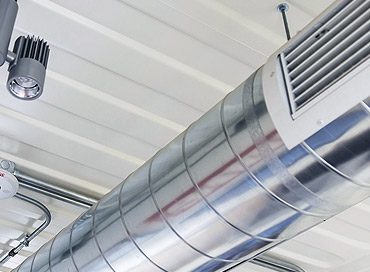Ductwork Installation

Ductwork Installation
New ductwork installation can apply to a new house under construction or an existing system that needs replacing. When replacing existing ductwork with a new duct system, it is generally a good idea to also do a new load calculation. The old HVAC system may not have been sized properly in the first place, and replacing the entire HVAC system again with the same size of air ducts could create the same range of issues as before. This is because square duct comes as two halves, while round duct comes at lengths of pipe.
So when starting a new HVAC installation or ductwork installation, the entire system has to be measured out in linear feet.
Why should I replace my HVAC ductwork?
There are quite a few reasons to replace your home’s ductwork system.
Dusty Home – Are you always cleaning dust off the surfaces throughout your house? This is a sign your ducts are dusty both on the inside and the outside. For lightly dusty ducts, try contacting a duct cleaning company. They will do a great job on the cost of cleaning inside your ductwork and save you on the other labor, supplies, and costs associated with replacing ductwork.
Poor Airflow – This is the number one reason for uneven or inconsistent temperatures throughout your house. Airflow restrictions and leaks in air ducts can be caused by broken, disconnected, or undersized ductwork and should be repaired or replaced.
Musty Smell – When moisture and humidity combine together, they can create mold. Eventually, mold will give off a musty smell, which can settle into multiple areas of the house. Duct cleaning can help with faint musty odors; however, the only guaranteed way to get rid of these smells would be to replace that whole section with new sheet metal ductwork.
Noisy Furnace and Air Conditioning – Has your furnace and air conditioning system been making odd noises? It could be your ducts and not your actual HVAC system. Loose and unsecured air ducts will vibrate more often, so installing ductwork and ensuring duct connections are sealed and properly supported will hopefully stop these noises.
Ducts are Old and Damaged – Ductwork is considered old after roughly 15 years of use. Depending on the quality of ductwork repair and installation, after 15 years, these ducts could be dusty or completely falling apart. Dents in air ducts are ugly and can potentially cause air leaks that lead to airflow issues, uneven temperatures, more dust throughout the house, and even creepy crawlies making a home inside the air ducts.
Ductwork Terms
Here are some useful terms to know about your next HVAC unit ductwork installation project.
Supply and Return – The supply air side of the HVAC duct system starts after the blower fan that circulates airflow in the house. The return air side brings air from each room back to the fan. The easiest way to understand the difference between the two is the supply air is forced out into the ducts while the return air is sucked back through the ducting into towards the blower wheel.
Plenum – This is the largest air duct in the system. It sits on top of the furnace or air handler on the heat supply or central air conditioning side, where the main trunk line take-off starts. The plenum is almost always a square ducting. A normal plenum size is approx 17.5″ x 20″ but can vary for different furnace/air handler widths. The return air drop is also a type of plenum; however, it is typically thinner and longer than the supply plenum. The most common size for a return air drop is around 8″x 24″ or 10″x 24″.
Main Trunk – This can apply to both return and supply trunks; however, most people are just referring to the supply. These are smaller in size than the plenum and will typically go down in size after a certain distance in order to keep air velocity consistent. They can be either round or square ducts.
Branch Lines – Branch lines are attached to the main trunk line and branch off to supply registers throughout the house. They are the smallest ducts, usually 5″ in diameter and always round.
Conclusion
In conclusion, replacing or installing ductwork can help homeowners address a range of issues, from dust accumulation to uneven temperatures and mold. When considering replacing ductwork, it is important to have a professional inspect the HVAC system first and perform a load calculation to ensure the proper size ducts are installed. When discussing ductwork installation with professionals, homeowners should be aware of terms such as plenum, main trunk, and branch lines.
Although assembling square sheet metal ducting can be tedious, a professional installation will result in a more efficient HVAC system and a more comfortable living environment.

Peace of mind for you and your family.
Efficient Energy Systems has over 45 years of experience in the HVAC service industry. Fully licensed and insured.

